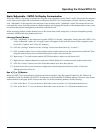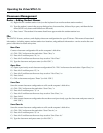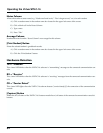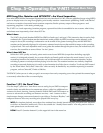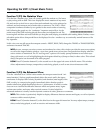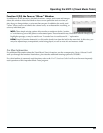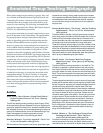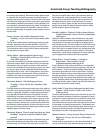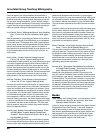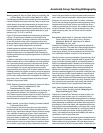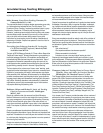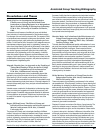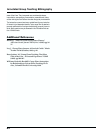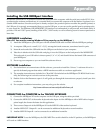
from private to group teaching. Musicianship classes, repertoire class-
es, ensemble work, and technique sessions are offered as ways of
blending private and group instruction. Particularly useful is the second
half of the article, which goes into detail concerning the group teaching
skills needed by the effective class teacher. Grouping techniques, les-
son organization, understanding the learning process, and leading the
group are all carefully explained. Those teachers looking for informa-
tion on the beginning steps for developing a group program will want to
read this article.
Carson, Carolyn. “Put a Little Classroom in Your
Teaching.” Clavier Vol. 20, No. 9 (November, 1981):
p.44.
This brief article contains ideas for enhancing group lessons through
motivation, creative activities and studio decoration. A short list of
resources for the classroom teacher is given at the end of the article.
This source serves mainly to start the flow of ideas concerning effec-
tive organization of the group studio.
Cheek, Sharon. “Misconceptions About Group
Teaching.” Roland Keyboard Educator Vol. 3, No. 4
(Fall, 1999): pp.8-10, 14.
Nine common misconceptions by parents and teachers are met with
logical and innovative answers in this article. Many of the misconcep-
tions stated are likely to be heard from parents or other teachers at
some point, and knowledge of the facts supporting group piano instruc-
tion may be of great use to the independent teacher incorporating
group lessons into the studio. Lack of private attention, varying learn-
ing speeds of students, and problems with individual technique are
answered in such a way as to strengthen the argument for the use of
group piano lessons by more and more teachers.
Chronister, Richard. “The Challenge of Group
Teaching.” Clavier Vol.15, No. 8 (October, 1976):
pp.40-42.
Chronister reveals some misconceptions about group piano teaching in
this article. Lack of extensive equipment is dismissed with the following
comment: “A great deal of equipment, including expensive electronic
labs, used badly diminishes the success of the teacher. One piano
used effectively can produce marvelous results.” Instead, the author
places importance on the teacher’s ability to teach a group as a class
and not merely a collection of individuals. Ideas for sightreading, intro-
ducing new concepts, repertoire work, and performance opportunities
are offered with special consideration to teaching the class as a cohe-
sive group. Some of the pitfalls of the beginning group teacher may be
allayed by applying Chronister’s ideas.
Chronister, Richard. “Does Group Piano Help You Teach
Reading?” Keyboard Companion (Winter, 1996):
pp.12-16.
Chronister poses a question concerning the link between group piano
study and the development of reading skills, which is answered by
Christopher Hepp and Christine Hicks, Kathy Nafius, and Sue Collier.
Hepp points to specific areas in which group instruction boosts stu-
dents’ reading skills, including development of the musical area of
reading (utilizing rhythm drills, flashcards, step-skip exercises, etc.)
and a group activity he refers to as tachistoscoping. The second
answer to Chronister’s question is aimed more at the psychological
benefits of group study with additional information given on reading
activities for teams, partners and relay tasks.
Fairchild, Judith A. “Teacher’s Guide to More Effective
Group Piano Study.” Piano Guild Notes (May/June,
1996): pp.4-6.
Despite this article’s limitations due to its adherence to one specific
method, the novice group teacher will appreciate the specific guide-
lines presented in this outline format. Objectives of beginning piano
study are listed, and the “Ten Positive Aspects of Group Piano” may be
used in extolling the benefits of group study to the parents of your stu-
dents. Brief plans for ten lessons are given, with the target class being
beginning students (ages 8-10) in one-hour sessions. The scope of
assignments in a group setting, a detailed plan for the first class meet-
ing, and suggestions for musicianship study are examined.
Hardy, Diane. “Group Teaching – A Complete
Preparation.” American Music Teacher
(September/October, 1980): pp.18-19.
A basic introduction to the use of group teaching in the independent
studio is offered with guidelines for pacing, sequencing, discipline, and
activity selection. This particular teacher schedules three private les-
sons and one group lesson per month for each student. The group
takes place in the early morning, when schedules are open and atten-
tion spans are greatest. An itinerary of a sample class includes drill,
ensemble playing, theory games, listening activities, sight-reading, per-
forming, composing and ear training. By presenting the group class as
a privilege for the piano student, teachers may find their students excit-
ed about learning important musical concepts.
Jenks, Linda. “Group Piano Techniques for the Private
Teacher.” American Music Teacher Vol. 34, No. 2
(1984): pp.10-14.
Common issues associated with group piano instruction are met in this
article. Included are discussions on classroom management, financial
considerations, areas of teaching focus and varied uses of class piano.
Noteworthy is Jenks’ inclusion of a typical class piano experience,
which takes the reader through an entire class meeting from the arrival
of the students to previewing new assignments. The paragraphs deal-
ing with outfitting a piano lab both encourage group piano for those not
possessing a technological studio, and outline the process through
which teachers may obtain a fully-equipped piano lab.
Johnson, Rebecca. “Group Lessons: They’re Not Just for
Beginners.” Clavier Vol. 20, No. 10 (December,
1981): p.27.
Positive results of group teaching for more advanced students are the
main focus of this article. Many teachers associate group study in
Annotated Group Teaching Bibliography
37



